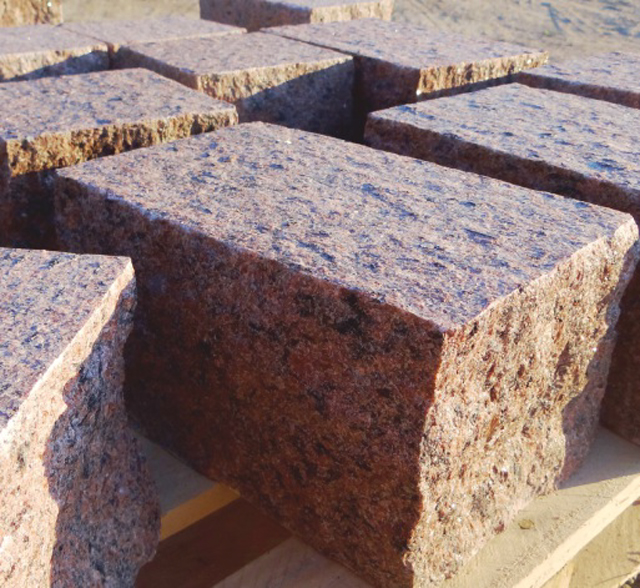SELECTING THE CUTTING FORCE

This article is a short excerpt from a paper presented by Krzysztof Nowakowski (WRKB-Granit Sp. Z oo) and Michał Firlej (Laboratory for Testing Stones and Aggregates/Artificial Aggregates) at the conference “Utilisation of Mineral Resources” that was held in Olomouc on 11 May 2016.
WRKB-Granit Sp. z o. o. is Swedish producer of natural stone products that is well-known in Poland. Many of the articles are cut stone slabs – fire treated and sanded setts, palisades and kerbs. The articles are typically made from igneous rocks: Granite Bohus, Granite Flaming, Granite Flivik Mahagon, Granite Vanga and Noryt Szwed, i.e. hard rocks.
When planning to expand the company’s machinery fleet, it was decided to simulate the behaviour of the gantry cutter on the materials used for the selection of products because the current practice suggests that the compressive forces of the Widia knives are insufficient for a semi-finished product made of hard stone.
It was assumed that the production line would be equipped with two cutters with Widia straight knives with the working dimension 180 x 20 cm and 40 x 20 cm.
For this purpose, two plates with soldered Widia knives were installed between the pressure plates of a laboratory press.
The following conditions were set for the test:
- the testing machine must comply with the EN 12390 norm,
- the testing samples will be 20 cubes with the dimensions 100 x 100 x 100 mm dried to a constant weight at 70 °C,
- the loading rate will be 0.20 MPa/s,
- the upper strength limit F [N] will be determined,
- the compressive strength R = F / A [MPa] will be calculated.
For each of the stones, a compressive strength test was carried out on twenty samples tested systematically over a period of 6 months.
Table 2 summarises the expected higher values for each material. The results clearly indicate that there is no direct relationship between compressive strength and fracture strength.
| Attribute | Unit | Bohus | Flaming | Fivik Mahagony | Vanga | Szwed |
| Compressive strength | MPa | 203 | 227 | 252 | 210 | 268 |
| Flexular strength | MPa | 13.5 | 16.8 | 16.7 | 12.4 | 24.8 |
| Absorption under compression | % | 0.18 | 0.14 | 0.12 | 0.14 | 0.04 |
| Weight | kg/m3 | 2630 | 2630 | 2670 | 2620 | 3020 |
| Porosity | % | 0.5 | 0.4 | 0.3 | 0.4 | 0.1 |
Table 1. Attributes of the material used in production
When choosing the cutting force, we take into account the material that is the most difficult to cut, i.e. Swedish granite. The force F required to destroy the element will be calculated from the formula F = 1.2 * R * A where:
R – Compressive strength [MPa]
Aflaming – slab area [mm²]
Taking into account the previously specified cutting force of Swedish granite (13.1 MPa) for the initial assumptions regarding cross-section size and raw material type – the calculation of the working force of the cutting machine will be as follows:
– for the section 180 x 20 cm: 13.1 x 1800 x 200 x 1.2 = 5659 kN
– for the section 40 x 20 cm: 13.1 x 400 x 200 x 1.2 = 1258 kN
| Material | Strength limit (MPa) | Compressive strength (MPa) |
| Flaming | 7.3 | 227 |
| Fiwik Mahagony | 8.9 | 252 |
| Bohus | 9.5 | 203 |
| Vanga | 10.4 | 210 |
| Szwed | 13.1 | 268 |
Table 2. Test results
Source: kurier kamieniarski
Author: Michał Firlej | Published: 27.6. 2016
